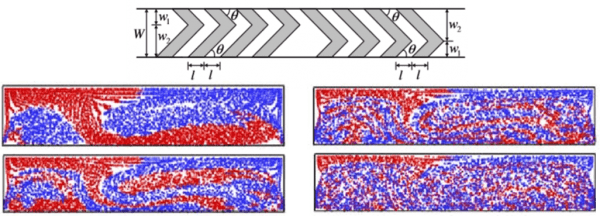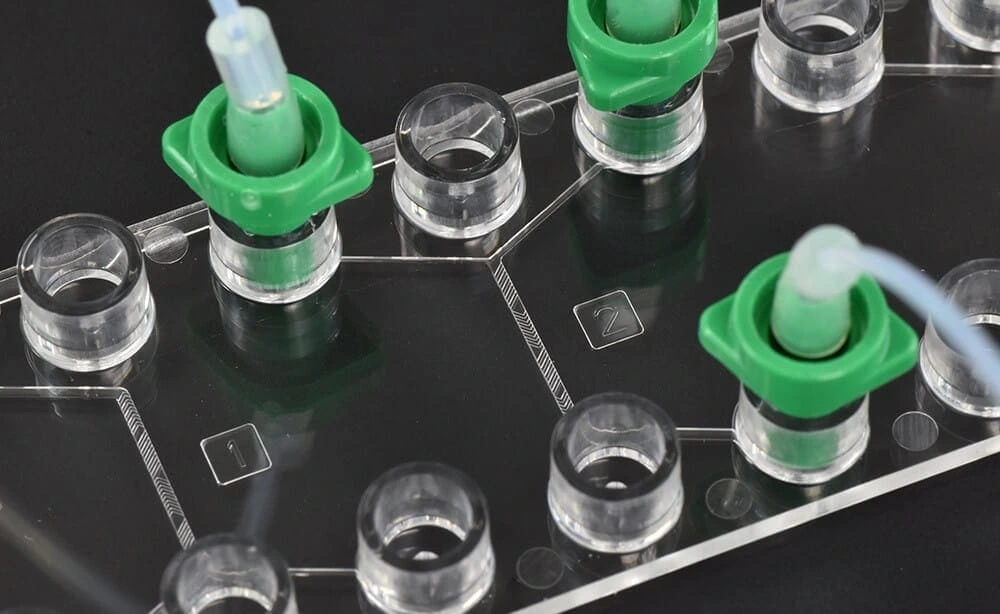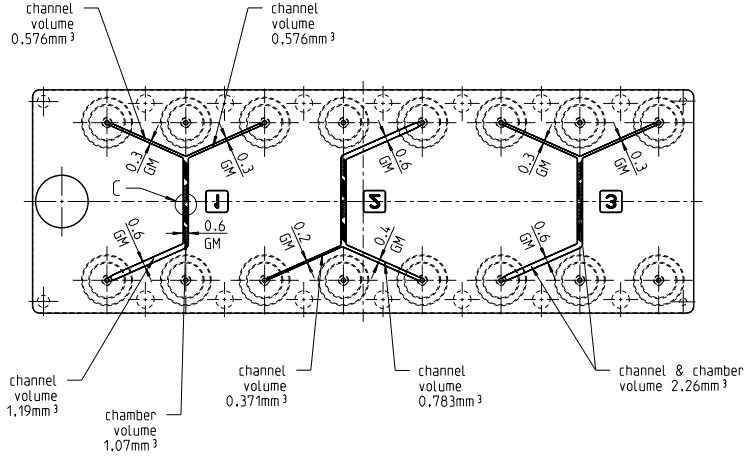Herringbone micromixing pack
Fluid mixing straight out of the box
Herringbone micromixer for chaotic flow
No need for an active mixing device like a magnetic stir bar
Easy passive mixing
Unbox, set up and start your experiments right away
Rapid effective mixing
Good homogeneity at the channel outlet
Lipid nanoparticle production possibility
From 60 to 250 nm with flow rates from 100 µL/min up to 30 mL/min

Need a microfluidic SME partner for your Horizon Europe project?
Herringbone channel drawing and mixing confocal micrographs figure by Stroock et al. (2002).
Microfluidic flow micromixing
Mixing two fluids in a microfluidic channel has never been easier using the microfluidic herringbone micromixer pack for many possible applications like immunoassays, mixing PCR solutions, or chemical synthesis!
Based on a high-accuracy flow controller and a herringbone mixing chip, this all-in-one solution contains all the required parts for researchers to set up their own mixing system with a high flow rate and mixing efficiency.
If you are a beginner with microfluidic technologies, our microfluidic experts will support you through all the steps needed to set up and perform your experiment. The herringbone micromixer pack can be used for several applications, including lipid nanoparticle synthesis.
A standard two-fluid mixing all-included pack contains two pumping channels to push the two fluids to mix through the herringbone micromixer chip, allowing the rapid creation of a homogenous fluid at the outlet of the chip by inducing a chaotic flow.
The mixing efficiency will be directly linked to the fluids’ properties and the flow rate inside the channel. Flow rates can be measured thanks to multiple flow rate sensors.
Herringbone micromixing setup
A preassembled pack guarantees good compatibility between the different parts, allows you to start your experiment right out of the box, is piloted by a single flexible software, and can be used for other different purposes. Therefore, a pack is the easiest way to set up micromixing for beginner and expert users.

The herringbone pack contains:
2 x Microfluidic flow sensors (Galileo, MIC)
Software (Galileo user interface)
Flow controller
2 x 15 mL Falcon reservoir caps
Microfluidic chip from microfluidic ChipShop (for example, Fluidic 187)
All necessary accessories: tubing, connectors, filters, etc.
Microfluidic herringbone micromixer principle
The staggered herringbone micromixer chip is a chaotic advection channel, meaning that transverse flows are generated that cause advection that is not in the same direction as the flow [1]. This design has been specially created to generate a helical flow pattern in the microchannel [2] which greatly improve the mixing of the two fluids [3-4].
Indeed, the staggered herringbone micromixer chips are way more effective than the more classic-shaped micromixer like T-shaped or Y-shaped micromixers. They can be as effective as these types of mixing channel even when it is about 100 times shorter in length [5].
Micromixing is useful for various applications like combinatorial or organic chemistry, handling hazardous substances, PCR, screening, and many more [6-9].

Advantages of microfluidics for fluid mixing
Working with microfluidics for chemistry is a way to greatly decrease the amount of reagents used per experiment, which can lower cost and waste output.
Moreover, at the microfluidic scale, fluid properties can be precisely tuned, and very fast kinetics is possible, which is important for crystallization and precipitation processes for synthesizing polymeric nanoparticles, for example.
Microfluidics also enables precise control reactions in the micromixer by adding specific reagents at specific moments during the experiment.
Micromixers allow the reaction to be isothermal thanks to the increased heat transfer in microreactors.
Since staggered herringbone micromixers are miniaturized, this mixing part can be integrated into a more complete experiment platform to perform complicated and multifunctional processes.
To summarize, micromixers and, more specifically, staggered herringbone chips allow more flexible, precise, and efficient mixing between two fluids.

Reference
Ottino J (1989) The kinematics of mixing: stretching, chaos, and transport. Cambridge University Press, Cambridge
Stroock AD, Dertinger SKW, Ajdari A, Mezic I, Stone HA, Whitesides GM. (2002), Chaotic mixer for microchannels. Science, 295, 647-51
Johnson T, Ross D, Locascio L (2002), Rapid microfluidic mixing. Anal Chem, 74, (1), 45-51
Stroock A, Dertinger S, Whitesides G, Ajdari A (2002), Patterning flows using grooved surfaces. Anal Chem, 74, (20), 5306-5312
Capretto L, Cheng W, Hill M, and Zhang X, (2011), Micromixing Within Microfluidic Devices, Top Curr Che, 304, 27-68
Wilms D, Klos J, Frey H (2008), Microstructured reactors for polymer synthesis: a renaissance of continuous flow processes for tailor-made macromolecules? Macromol Chem Phys, 209, (4), 343-356
Zhang C, Xing D, Li Y (2007) Micropumps, microvalves, and micromixers within PCR microfluidic chips: advances and trends. Biotechnol Adv, 25, (5), 483-514
Dittrich P, Tachikawa K, Manz A (2006), Micro total analysis systems. Latest advancements and trends. Anal Chem, 78, (12), 3887-3908
Dittrich P, Manz A (2006), Lab-on-a-chip: microfluidics in drug discovery. Nat Rev Drug Discov, 5, (3), 210-218
Chang C, Yang R (2007), Electrokinetic mixing in microfluidic systems. Microfluid Nanofluid, 3, 501–525
Customize your pack
The staggered herringbone micromixer chip provided by Microfluidics ChipShop is available in Polycarbonate (PC) or Cyclo Olefin Copolymer (COP) materials, channel depth: 200 µm; channel width inlet: 300 µm; channel width mixer: 600 µm; channel width outlet: 600 µm.
The efficiency of the mixing depends on the Reynolds and the Peclet number. If you’re unsure about the settings that are best suited for your application, get in touch with one of our experts!


Additional pumping channels for the flow control pump and flow rate sensors can be added to the pack.
Use a sequential-injection instrument to perform a recirculation loop to improve the mixing with each cycle.
Bubbles can be a problem when mixing; a bubble remover can be provided to tackle this issue if it is critical for a specific experiment.
Substance mixing can also be achieved with other strategies like planar serpentine micromixers.
You can contact our scientists to answer any questions about this herringbone micromixer pack and how it can match your specifications.
Frequently asked questions
Can I order a pack?
Since Packs are products that are still being developed, we have a few eligibility criteria to maximize their success rate. A discussion with our experts is needed to determine your specific needs to offer you a personalized response.
Is the setup sterilizable?
Yes, we have developed a simple protocol for sterilization and cleaning that is provided along with the user guide.
Can a pack be customized based on my specific application?
Yes! Our experts will establish which instruments are best suited for your application, such as the type of flow sensor or the number of flow controller channels you need to perform your experiment. Contact us using the “talk to our experts” green button above.
Can I buy individual instruments?
Our instruments are in beta testing phase and can be tested as a pack or individually, so get in contact with our team to know how our beta testing program works.

